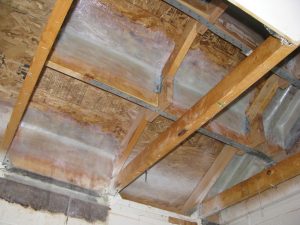Seismic Retrofit of Masonry Structures with Wood Diaphragms
Fiber Reinforced Polymers (FRPs) have been used for seismic retrofit applications in masonry and concrete structures for many years. FRP has also been used for general restoration purposes in wood structures. Examples include repair and strengthening of wood columns or posts by wrapping with FRP and strengthening of wood beams by either wrapping beams with FRP or by placing FRP of the sides or bottom of wood beams.
When seismically retrofitting masonry shear wall structures with wood roof diaphragms, common seismic retrofit approaches often require partial or total removal of roofing materials, present over the top of plywood roof sheathing, to install diaphragm boundary and other nailing. Thus, it is ideal to construct such retrofit measures when re-roofing is required for maintenance reasons. Sometimes, conventional methods (where roofing material removal is required) are not preferred, either because the roofing materials have many more years of remaining life or partial roof removal is impractical due to warranty concerns and roof construction type, i.e., standing seam roofing materials. In these cases, consideration of alternate methods to achieve in-plane and out-of-plane load transfer from the structural walls to and from the roof diaphragms should be considered. The use of FRP materials bonded to wood framing and roof sheathing can be evaluated as a possible method of achieving the required connections.
Several different FRP/wood installation configurations were recently reviewed to address many of these challenging conditions. These included in-plane shear transfer for three situations: 2X wood roof framing to plywood sheathing, 2X wood roof framing to oriented strand board (OSB), and plywood or OSB to masonry walls. FRP as a shear transfer material between 2X wood members and plywood (or OSB) sheathing required testing to validate the effectiveness of this approach and to determine allowable design capacities.
On a recent seismic upgrade project in Utah, the design team determined the design loads associated with each configuration where FRP/wood connections were being considered. The team then developed a testing program in cooperation with a major FRP manufacturing company. The testing program consisted of testing multiple configurations of fiberglass composite sheets bonded onto plywood and 2X wood members. The samples were tested in compression to determine the shear strength of overall wood/plywood/FRP assembly. The plywood was oriented both parallel and perpendicular to the grain orientation of the 2X wood members. Plywood was also subjected to direct pull-off bond testing per ASTM D4541. The ultimate strength design (USD) shear design loads generally ranged from 500 pounds/linear foot (lbs/lf) to 1,000 lbs/lf. The mean ultimate shear strength (at failure) from testing was 6,900 lbs/lf, with a standard deviation of 850 lbs/lf. Failure modes were consistently wood failure by plywood de-lamination. FRP de-lamination did not occur in any specimen.
The design team proceeded to develop final construction documents utilizing FRP in wood-to-wood and wood-to-plywood (or OSB) connections using data from testing. An installation photograph at a representative location is included in this article. (It is noted that the use of various FRP materials bonded to CMU has been widely used, and well-documented design methods exist. Thus, while the CMU to FRP capacity was included in design calculations, this is not discussed in this article.)
Quality control and surface preparation requirements are critical when bonding FRP materials to any substrate. For wood-to-wood FRP applications, surface preparation included light abrasion of wood and plywood with a grinding wheel. In the case of FRP attachment to OSB, only very light abrasion is preferred. Light cleaning of wood surfaces with acetone was then done. A bonding agent was applied prior to application of glass fiber sheets and polymers. Field testing included direct pull tests, using the same pull test methods as in laboratory testing. Quality control measures included monitoring surface preparation, verification of provided materials before installation, and field inspections of installed conditions. These field inspections included verification of areas of material bonded to wood, verification of lap splice lengths, and inspection of the completeness of bond to wood (i.e., the absence of de-lamination or voids beyond prescribed acceptable levels). Other factors, such as the required radius of FRP at orthogonal member connections, correlation of existing wood types to test specimen types, and grain direction of wood are also important, but not discussed in this article for brevity.
FRP is an effective material for use in seismic retrofitting of wood roof systems in masonry buildings. The procedures used made it possible to construct seismic retrofit measures without reroofing, thereby reducing total project costs by more than 50%. Furthermore, given the favorable test results, the use of FRP for wood-to-wood connections need not be limited to situations where roof removal is to be avoided, nor do uses need to be limited to CMU wall structures. Potential uses of FRP for seismic strengthening of wood structures could include roof and floor diaphragm strengthening in concrete shear wall or brick shear wall structures. The concepts presented are also applicable for strengthening of wood diaphragm connections for other lateral loads, such as wind loads. Further testing to develop building code design standards for FRP uses described in this article would be appropriate.▪

